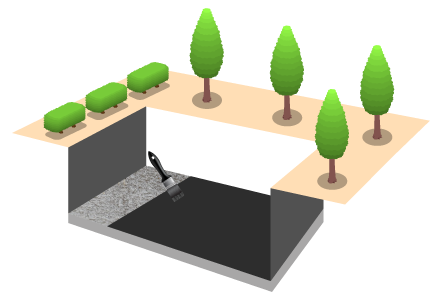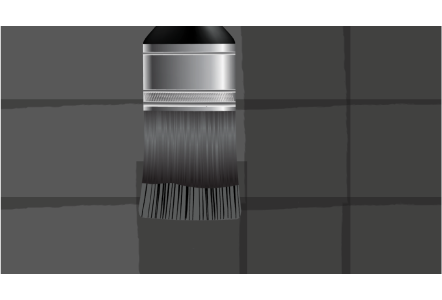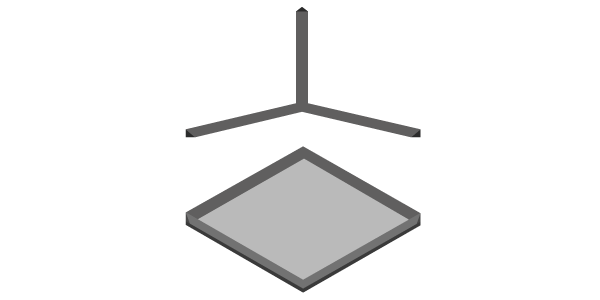Summary of application
Step 1: Protection of Lean concrete with Water Guard 491.
Step 2: Addition of Max Flo integra 3 (powder) Admixture in raft and retaining wall concrete.
Step 3: Application of Ressi Swell Bar Pro 60 (Swellable bar) in the retaining wall joint.
Step 4: Repairing of the concrete defects using Patch 365 Plus.
Step 5: Application of Water Guard Crysta Coat 101 over the surface of the concrete both internal and external.
Step 6: Making external and internal chamfers between the raft and the retaining walls using Patch 365 Plus.
Step 7: Plastering of all the areas of the water body with the addition of Ressi SBR 5850 and Silmix all over the concrete internally and externally.
Step 8: Application of Water Guard 491 on the external and internal plastered surface of the water body.
Step 9: Flood Test of the water body.
Step 10: Inspection and back filling.
Step 11: Laying of Screed over the water body prior to finishing / tile fixing.
Step 12: Finishing of the waterbody using Ressi TA 230 and Ressi TG Bathseal 2K.
Detailed description
Waterproofing systems should be applied with pools, fountains, water tanks, or drainpipes during the construction period to prevent the loss of water and subsequent leakages. Remedial waterproofing can be a risky and costly operation.

It is for this reason Ressichem has a variety of products proposed as a system to ensure long lasting swimming pools and waterbodies during its construction.


Step 1: Protection of Lean concrete with Water Guard 491.
Once the excavation of the ground has been done, it is important to constantly dewater the area and make sure that the area where the water body is to be constructed is kept dry. Once the excavation has been completed, stone soling is done after which lean concrete is laid. Once the lean concrete has been properly cured and dried, it is recommended to apply 2 coats of Water Guard 491 over the lean concrete surface. The application of Water Guard 491 is to be done in opposite right-angled directions (if the first coat is applied left to right, the second coat is applied top to bottom).

Once the excavation of the ground has been done, it is important to . Once the coating of Water Guard 491 has been dried out, it is recommended to sandwich the coating by applying another layer of lean concrete over the coating of Water Guard 491. The steel reinforcement is to be done over the second layer of lean concrete.

Note: Prior to concreting it is essential to make sure that the water inlet & outlet pipe sleeve provisions are already done within the formwork of the concrete so that there is no need for hacking or breaking the concrete after it has been casted.

Step 2: Addition of Max Flo integra 3 (powder) Admixture in raft and retaining wall concrete.
If possible, it is recommended to pour the raft and retaining wall of the concrete in one go. The addition of Max Flo Integra 3 (Powder) Admixture is recommended in the concrete. It is recommended to add at least 1 KG of Max Flo Integra 3 (Powder) for concrete produced for every 50 KG bag of cement. A proper engineering mix design for concrete can be done for efficient dosing of the concrete to achieve the right flow properties, strength, and reduced water permeability of the concrete.

Step 3: Application of Swellable bar in the retaining wall joint.
Incase if it is not possible to pour the raft and the retaining wall in one go, it is recommended to lay the retaining wall to at least 3 to 4 feet above the raft floor level. It is recommended to lay Ressi Swell Bar Pro 60 (Swellable bar) over the joint between the retaining walls (For further information on how Ressi Swell Bar Pro 60 is applied, please refer to the product Datasheet). Once the application of Ressi Swell Bar Pro 60 has been done, the remaining retaining wall should be poured with the addition of Max Flo Integra 3 (Powder) in it.

Step 4: Repairing of the concrete defects using patch 365 Plus.
In principle after concrete de shutter of the raft and retaining wall there should not be any defects within the concrete. Once the formwork has been removed. It is essential to repair all the defects of the concrete with Patch 365 Plus, it is a suitable repairing material for the minor concrete defects and the voids created by the metal strips (Incase wooden formwork has been used). Once the concrete is repaired and of a sound nature subsequent treatment of various waterproofing materials can be done over the concrete surface of the basement.

Step 5: Application of Water Guard Crysta Coat 101 over the surface of the concrete both internal and external.
Water Guard Crysta Coat 101 is a high end crystalline waterproofing slurry coat which is to be coated over the prepared concrete surface on all the exterior and interior surfaces of the Waterbody. At least two coats of Water Guard Crysta Coat 101 are recommended in right angled patterns. If the first coat is applied in top to bottom p

pattern the second coat should be applied in left to right patterns. It is recommended to make sure that all the concrete that has been casted internally and externally is coated properly with Water Guard Crysta Coat 101 (For further application guidance, please refer to the product datasheet)

Step 6: Making external and internal chamfers between the raft and the retaining walls using Patch 365 Plus.
It is recommended to use Patch 365 Plus to make the chamfers between the external walls of the raft and retaining walls. The chamfers should be at least 6 inches wide and should cover all the intersection of the external raft and the retaining wall area of the basement. Patch 365 Plus is a two-component cementitious high strength repair mortar; due to its high strength and durability it is an ideal material to be used for the making of chamfers in this case. Please refer to the product datasheet for further information.

Step 7: Plastering of all the areas of the basement with the addition of Ressi SBR 5850 and Silmix all over the concrete internally and externally.
Once all the chamfer work has been properly executed, the inner and outer surfaces of the basement should be ready to plaster. It is recommended to use Silmix and Ressi SBR 5850 as mortar admixtures to make sure that there is a reduction of cracks in the plaster and the plaster itself is water repellent. It is recommended to add 1 Liter ofSilmix along with 1 Ltr ofRessi SBR 5850 with every bag of cement used for the plastering of internal and external areas of the basement. It is to be ensured that the external plaster of the basement should be finished slightly rough, exposing some grains using a foam (Foam finish plaster). This will provide a good key for the subsequent coating of Water Guard 491.

Step 8: Application of Water Guard 491 on the external plastered surface of the water body.
Once all the internal and external plastering works have been completed, it is recommended to apply at least 2 coats of Water Guard 491 in all the external and internal areas of the water body. It is recommended that both the coats are applied in opposite right-angled directions.

If the first coat is applied with vertical brush strokes, the second coat is to be applied with horizontal brush strokes. (For further application and mixing guidelines of Water Guard 491, please refer to the technical datasheet of the product).

Step 9: Flood Test of the water body.
Once the coating of Water Guard 491 has been completed and it has been dried out completely, it is recommended to fill up the water body with water to check for any leakages. If there are leakages within the water body, it should be rectified.

Step 10: Inspection and back filling.
Prior to back filling of the waterbody, it is essential to have a final inspection and make sure that there are no spaces which have been left uncovered with any type of chemical treatment as previously explained in this system. If there any voids within the basements they should be properly addressed and made sure that it is watertight prior to back filling of the basement.
Note: In the entire process from excavation to the final finishing of the external retaining wall, it is to be ensured that there is constant dewatering of the waterbody area.

Step 11: Laying of Screed over the water body prior to finishing / tile fixing.
A screed is usually poured over the slab of the water body. It is recommended to use good strong mix design for the screed. It is also recommended to add Ressi SBR 5850 along with the addition of Silmix within the mix of the screed. The recommended dosage of Ressi SBR 5850 and Silmix is 1 Ltr each for every 50 KG Bag of cement used in the placement of floor screed over the slab of the water body. It is to be strictly ensured that the screed is placed in a slope moving towards the water drainpipes of the water body and all slopes need to be planned according to the need of the slope. If the slopes are not properly maintained, the functioning life of the waterbody may be reduced drastically and will cause many issues within the lifetime of the water body.

Step 12: Finishing of the waterbody.
Once the screed has been laid, cured, and dried out completely, a variety of tile adhesives and grouts are recommended to lay the tiles in the waterbody. Ressi TA 230 is the recommended waterproof tile adhesive for this application. It is an ideal tile adhesive for standard ceramic, porcelain, and large format tiles. The Recommended tile grout to be used in this case is Ressi TG Bath seal 2K. It is a mild acid resistant tile grout which does not deteriorate as quickly as ordinary cement or standard tile grout (Please refer to the technical datasheets of the product for more information)
Note: if any special tile or finishing is being conducted, please consult Ressichem representative for proper guidance.



What is a Chamfer?
Is a transitional edge between two faces of an object. Sometimes defined as a form of bevel, it is often created at a 45° angle between two adjoining right-angled faces. ( Wikipedia).
In waterproofing systems, making a chamfer is of great significance. Water normally gets stuck in areas which have sharp corners of 90° & on several occasions the leakage of water occurs from this the sharp angle of the water retaining bodies or areas where significant waterproofing is required. To minimize the effect of this, a chamfer is usually created to make sure that there are no sharp angles in the structure to minimize the effect of water coming in & out of the structur








